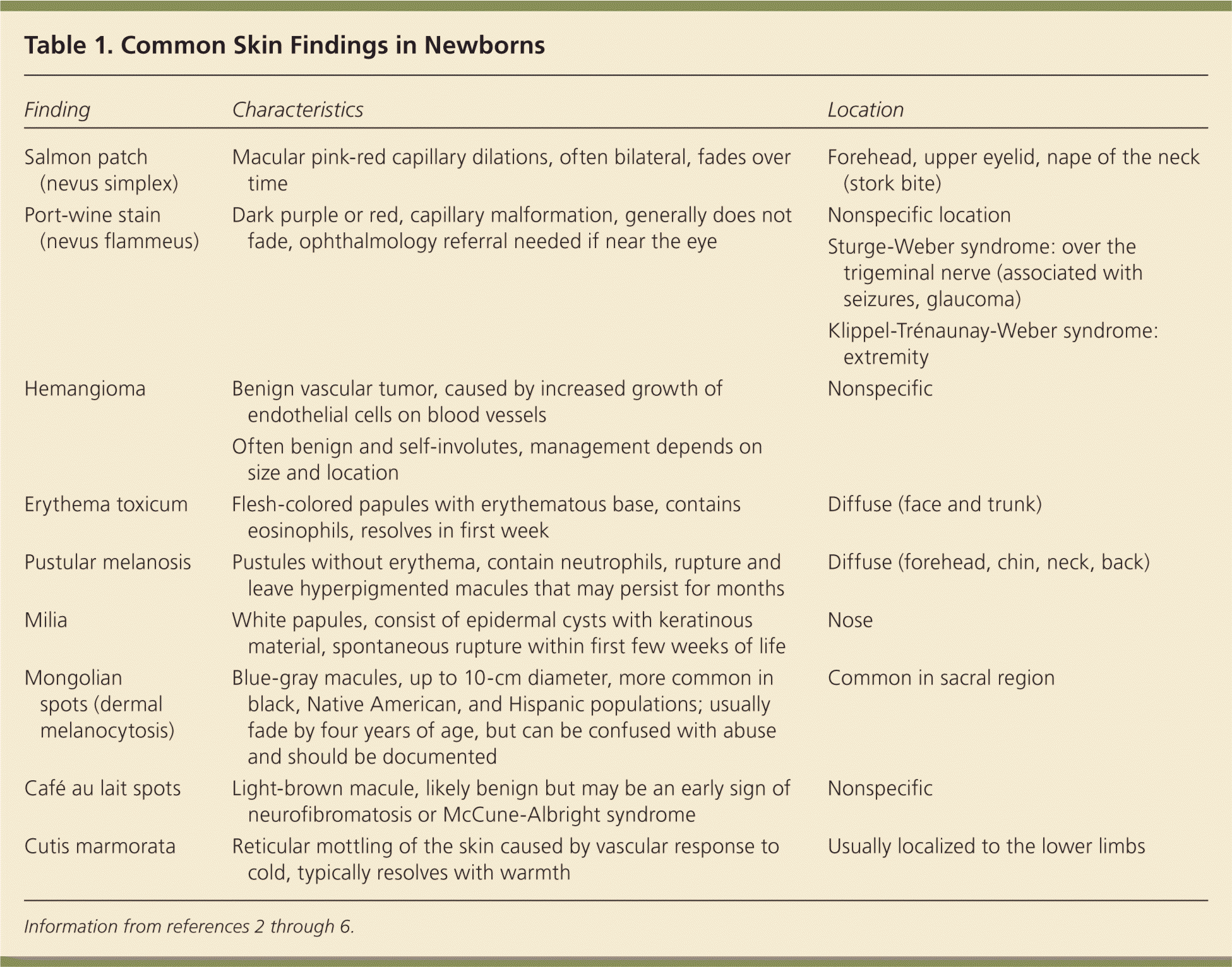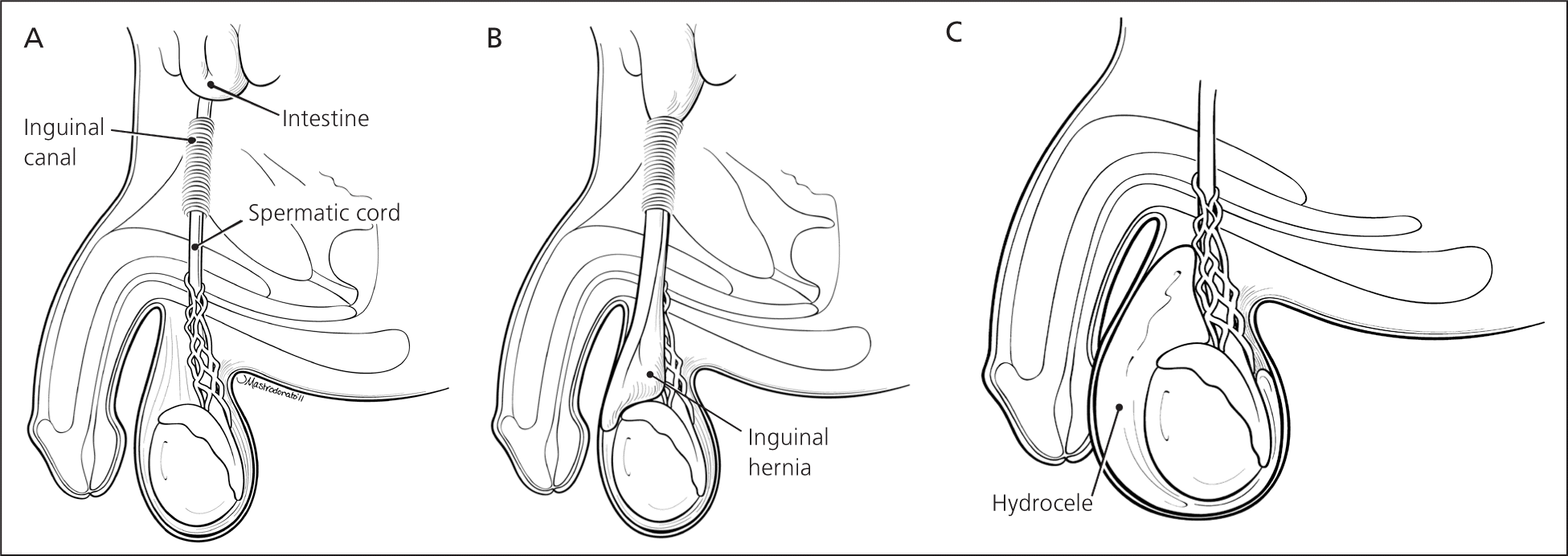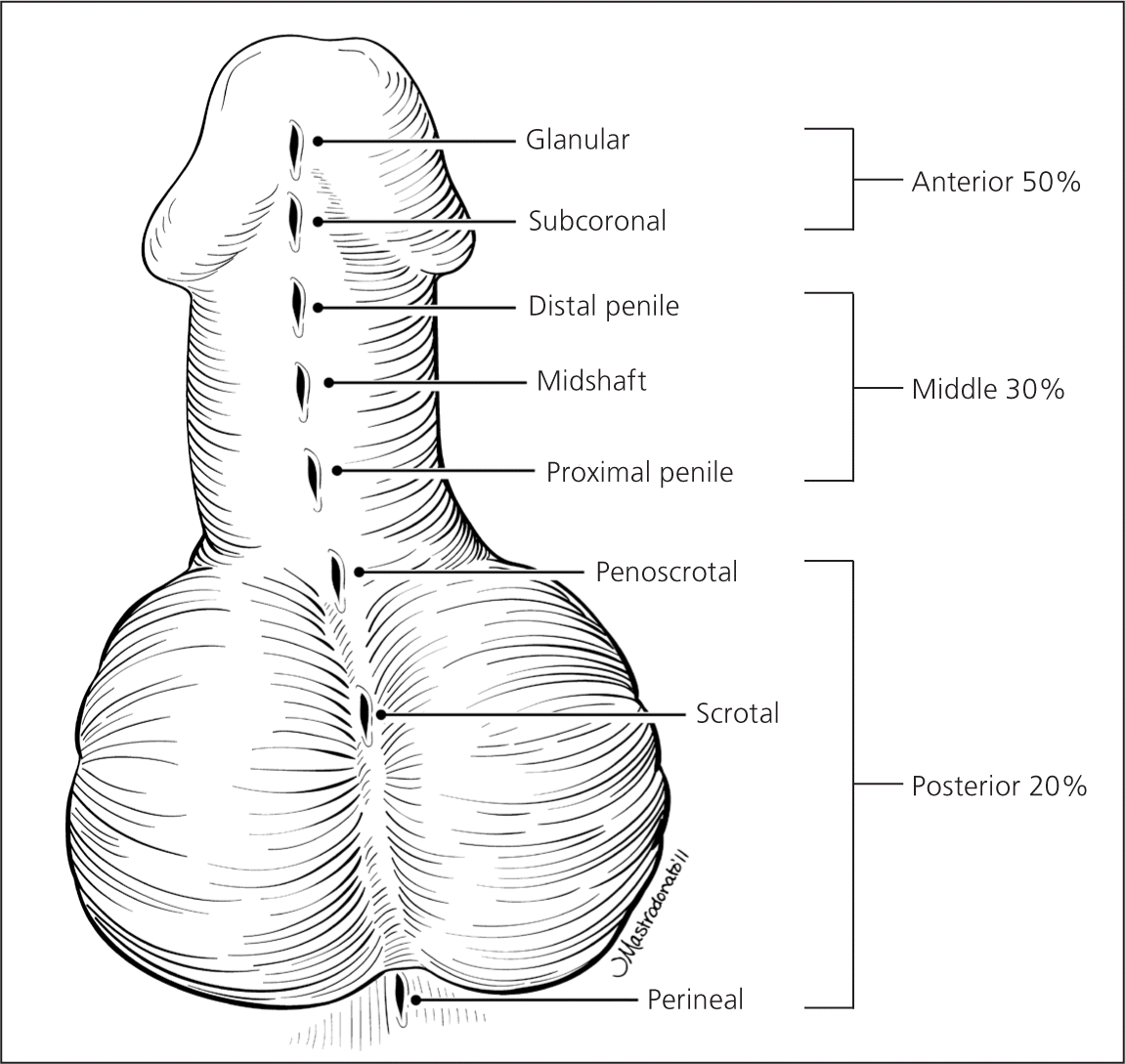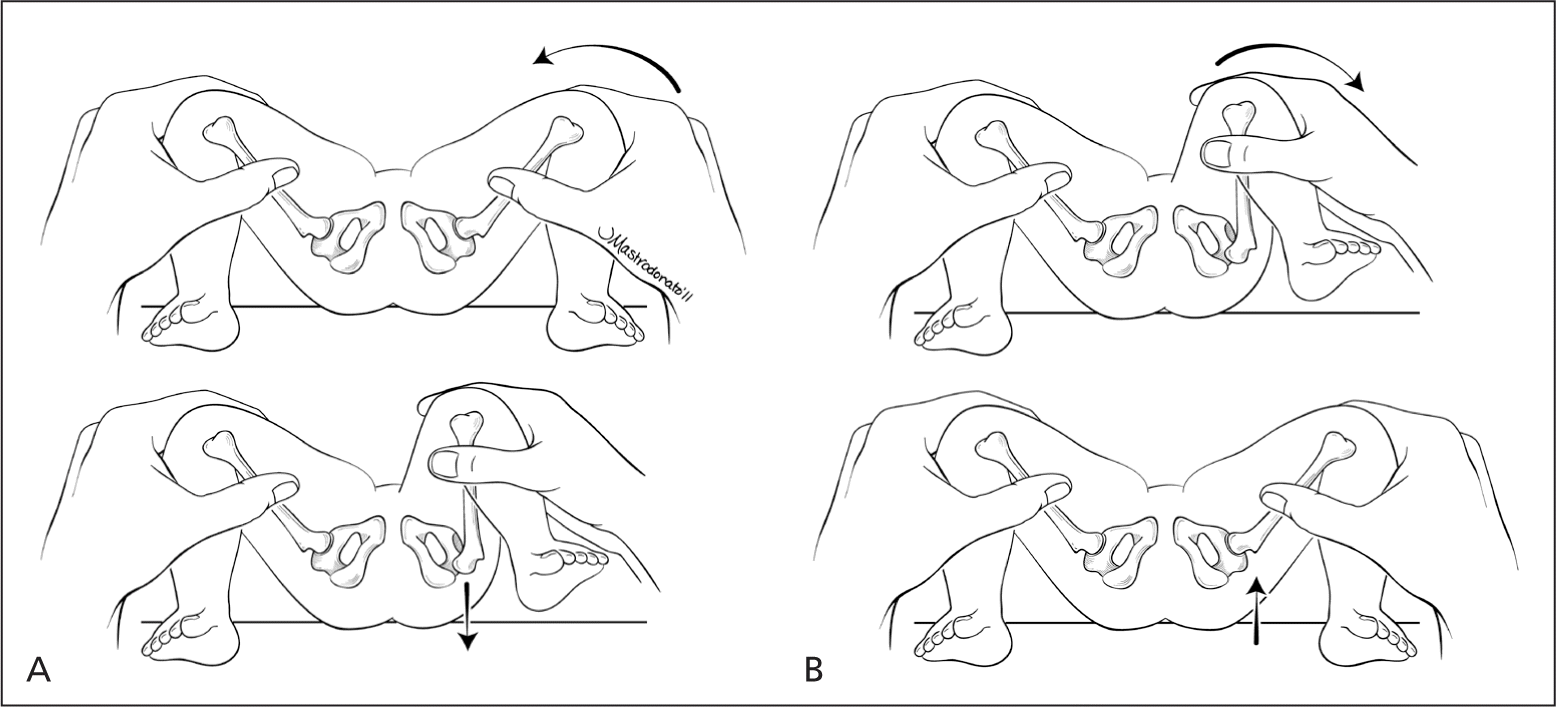
Am Fam Physician. 2014;90(5):297-302
This is part II of a two-part article on the newborn examination. Part I, “General, Head and Neck, Cardiopulmonary,” appears in this issue of AFP.
Author disclosure: No relevant financial affiliations.
Skin findings are common during the newborn examination. Although these findings are often benign, it is important to visualize the entire skin surface to distinguish these findings and appropriately reassure parents. The chest should be observed for symmetric movement, pectus excavatum, pectus carinatum, prominent xiphoid, or breast tissue. The infant should be as relaxed as possible so that the physician can more easily detect any abdominal masses, which are often renal in origin. A single umbilical artery may be associated with another congenital abnormality, especially renal anomalies, and intrauterine growth restriction and prematurity. Signs of ambiguous genitalia include clitoromegaly and fused labia in girls, and bilateral undescended testes, a micropenis, or a bifid scrotum in boys. Sacral dimples do not warrant further evaluation if they are less than 0.5 cm in diameter, are located within 2.5 cm of the anal verge, and are not associated with cutaneous markers; dimples that do not fit these criteria require ultrasonography to evaluate for spinal dysraphism. Brachial plexus injuries are most common in newborns who are large for gestational age, and physical therapy may be required to achieve normal function. Patients with abnormal findings on Ortolani and Barlow maneuvers should be evaluated further for hip dysplasia. It is also important to assess newborns for tone and confirm the presence of normal primitive reflexes.
Part I of this two-part article discusses the assessment of general health, head and neck, heart, and lungs.1 Part II focuses on assessing the newborn's skin, trunk and extremities, and neurologic function.
| Clinical recommendation | Evidence rating | References |
|---|---|---|
| Routine renal ultrasonography to look for renal anomalies in newborns with isolated cases of a single umbilical artery is not beneficial. | C | 11, 12 |
| Bilateral undescended testes, a micropenis, or a bifid scrotum should prompt investigation for ambiguous genitalia. | C | 15 |
| Newborns with a hypospadias should not be circumcised because the foreskin may be needed for repair. | C | 19 |
| A sacral dimple is simple if it is less than 0.5 cm in diameter, located within 2.5 cm of the anal verge, and not associated with cutaneous markers (discoloration or hypertrichosis). In the absence of these criteria, ultrasonography should be performed before three months of age to evaluate for spinal dysraphism. | C | 22 |
| Girls born in the breech position should receive imaging to evaluate for hip dysplasia. Imaging should be considered in newborns with a family history of developmental hip dysplasia and in newborn boys born in the breech position. | C | 33, 34 |
Skin
A variety of normal and abnormal lesions may be present on newborn skin (Table 1).2–6 Although these findings are often benign, it is important to visualize the entire skin surface to distinguish these findings and appropriately reassure parents.2–6 It is common to see bruising and petechiae, which typically resolve over time.

| Finding | Characteristics | Location |
|---|---|---|
| Salmon patch (nevus simplex) |
|
|
| Port-wine stain (nevus flammeus) |
|
|
| Hemangioma |
|
|
| Erythema toxicum |
|
|
| Pustular melanosis |
|
|
| Milia |
|
|
| Mongolian spots (dermal melanocytosis) |
|
|
| Café au lait spots |
|
|
| Cutis marmorata |
|
|
Jaundice, which may cause yellowing of the skin and eyes, is common and typically benign. However, very elevated bilirubin levels can lead to serious consequences, such as kernicterus and acute bilirubin encephalopathy. Thus, bilirubin levels should be evaluated carefully according to American Academy of Pediatrics guidelines.7
Chest
Chest movement should be symmetric. Asymmetry suggests an abnormality such as pneumothorax, cystic malformation of the lung, or diaphragmatic hernia. The physician should also observe for pectus excavatum, pectus carinatum, prominent xiphoid, and breast tissue (may be present in girls or boys as a result of maternal hormone exposure), all of which are generally inconsequential findings but may pose cosmetic concerns. Supernumerary nipples can occur in the vertical line from the axilla to the pubic region (the milk line) and require no treatment.8 Widely spaced nipples may be a sign of Turner syndrome.9 A prominent precordium may indicate a congenital heart defect.
Abdomen
When examining the abdomen, it may be beneficial to use one hand to hold the legs with the hips and knees flexed to help relax the newborn, and use the other hand to palpate the abdomen. General observation of the abdomen may reveal a scaphoid abdomen, which can indicate a congenital diaphragmatic hernia, or a distended abdomen, which may indicate an intestinal obstruction. The presence of a gastroschisis (intestines protrude through the abdominal wall without a sac, usually to the right of the umbilicus) or omphalocele (abdominal contents protrude within a sac at the midline) is usually known before delivery and warrants emergent surgical consultation.10 Diastasis recti abdominis is caused by a relative weakness of the fascia between the two rectus abdominis muscles and usually resolves on its own over time. Linea nigra is a dark pigmented vertical line appearing from below the umbilicus to the pubic symphysis that is caused by maternal hormone exposure and disappears over time.
The umbilical cord should be inspected for signs of infection and bleeding. It should contain two arteries and one vein. A single umbilical artery may be associated with another congenital abnormality, especially renal anomalies, and intrauterine growth restriction and prematurity. In the past, renal ultrasonography was routinely performed in newborns with a single umbilical artery; however, routine renal imaging in isolated cases has not been proven beneficial.10–12 Umbilical hernias, which are common in newborns, rarely become incarcerated or strangulated, and most resolve by the time the child reaches three years of age.
The abdomen should also be auscultated for bowel sounds in all four quadrants, and then palpated to feel for masses and organomegaly. It may be helpful to use the flats of the fingers rather than the tips. The liver is usually approximately 1 to 2 cm below the lower costal margin. About one-half of abdominal masses are renal in origin, such as multicystic dysplastic kidneys, Wilms tumor, hydronephrosis, renal vein thrombosis, and ureteropelvic junction obstruction. Other masses include teratoma, neuroblastoma, ovarian torsion, ovarian cyst, and gastric duplication cyst.13
Genitourinary
Term female newborns have prominent labia majora, whereas preterm female newborns have prominent labia minora and clitoris. A white discharge or small amount of blood may be present and is a normal response to maternal estrogen withdrawal. Separating the labia minora allows evaluation for patency of the hymen. Signs of ambiguous genitalia include clitoromegaly and fused labia. A hymenal tag may be present and usually requires no intervention.
In male newborns, both testes should be descended into the scrotal sac. Retractile testes can be milked into the scrotum and do not require intervention. Bilateral undescended testes, a micropenis (penile length for a term newborn is 2.5 to 3.5 cm),14 or a bifid scrotum should prompt investigation for ambiguous genitalia. Findings suggestive of ambiguous genitalia should be addressed urgently, and consultation with endocrinology, genetics, and urology is indicated. Gender should not be assigned until all information is obtained.15
Evaluation of the scrotum may reveal an inguinal hernia or hydrocele (Figure 1). An inguinal hernia occurs when the processus vaginalis fails to close, which leaves an opening for bowel to pass through and leads to a bulge in the inguinal canal that may extend to the scrotum. The hernia can often be reduced with pressure, and bowel sounds are sometimes auscultated.16,17 Inguinal hernias may incarcerate and strangulate, and thus should be surgically repaired. A hydrocele occurs when the failed closure allows only fluid to pass through and usually transilluminates with light. Hydroceles often resolve within the first one to two years of life.16,17

An American Academy of Pediatrics policy statement asserts that the health benefits of male circumcision (e.g., prevention of urinary tract infections, penile cancer, and transmission of some sexually transmitted infections) outweigh the risks; however, the procedure should be performed only if the parents choose it.18 Hypospadias is the abnormal ventral placement of the urethral opening, which may be within the glans, the shaft of the penis, or scrotum (Figure 2). Newborns with hypospadias should not be circumcised because the foreskin may be used for repair.19 Chordee is a ventral curvature of the penis. It is a contraindication to circumcision and warrants referral to urology for correction. A buried penis (a penis that retracts into a fat pad) should not be circumcised if the head is not exposed during rest because it could become trapped in the fat pad with postoperative swelling.20,21

Anus/Rectum
The rectum should be examined for normal placement and patency. A sacral dimple is considered simple if it is less than 0.5 cm in diameter, is located within 2.5 cm of the anal verge, and is not associated with cutaneous stigmata (e.g., hairy patches, hemangiomas). Classically, sacral dimples that do not fit these criteria have prompted ultrasonography before three months of age to evaluate for spinal dysraphism.22,23 Recent information has shown that this may not be the best criteria for ultrasonography because evaluation for complex dimples without associated nonneurologic congenital abnormalities is unlikely to reveal an abnormality requiring surgical intervention. However, ultrasonography is a simple, noninvasive procedure and a good detector of a tethered cord, if present.24 An imperforate anus may be a sign of a syndrome or may be an isolated finding. A VACTERL association includes vertebral/vascular, anorectal, cardiac, tracheoesophageal, radial/renal, and limb anomalies. It is also commonly seen with trisomies 18 and 21.
Extremities
The hands and feet should be inspected for syndactyly and polydactyly. Supernumerary digits arise from the lateral surface of a digit, most commonly on the ulnar aspect of the little finger, and vary from a complete digit with a nail bed and cartilage to a small amount of pedunculated skin. These digits are usually benign but are removed for cosmetic reasons. Supernumerary digits without bone involvement usually can be tied off at the base, whereas digits with bone often need surgery, which should be performed by a skilled plastic surgeon. Polydactyly may be an isolated abnormality but warrants a careful physical examination to investigate for other genetic abnormalities.25 A single palmar crease may be a sign of trisomy 21 syndrome, but also occurs in 3% to 10% of persons without the syndrome.26,27 Clinodactyly (curvature of the fifth digit) may be hereditary or a sign of a variety of syndromes, including Turner syndrome and trisomy 21 syndrome.28,29
Various palsies may occur in association with brachial plexus injury. These injuries are more common in newborns who are large for gestational age, especially those with shoulder dystocia or a prolonged delivery. An Erb palsy results from a traction injury to the C5 to C7 spinal nerve roots and may cause the newborn to hold his or her arm medially rotated to the side with the hand pronated (“waiter's tip”). A Klumpke palsy involving lower segments of C8 and T1 results in paralysis of the entire arm with absent reflexes. A variant of Klumpke palsy, known as Klumpke paralysis, produces a claw hand, in which the forearm is supinated and the wrist and fingers are flexed. Palsies may require physical therapy.30
Talipes equinovarus, or clubfoot, is a common orthopedic abnormality impacting one per 1,000 births. This abnormality results in the inversion and adduction of the forefoot, inversion of the heel and hindfoot, limited extension of the ankle and subtalar joint, and internal rotation of the leg. The examiner should first determine if this is merely a positional deformity that is easily corrected with manipulation and requiring no further management, or if it is truly talipes equinovarus necessitating an orthopedic consultation and usually casting.31 Pedal edema in the newborn may indicate Turner syndrome.32
When evaluating the hips for dysplasia, each hip should be examined separately with the other hand stabilizing the pelvis (Figure 3). The Barlow maneuver involves adducting the hip while pushing the thigh posteriorly to see if it can be dislocated. The Ortolani procedure tests for posterior dislocation of the hips and is considered positive if a clunk is heard when the femoral head relocates anteriorly into the acetabulum. If the results of the newborn hip examination are equivocally positive (i.e., a soft click and mild asymmetry without an Ortolani or a Barlow sign), a follow-up hip examination two weeks later by the child's physician is recommended. An article in American Family Physician includes a full description of the assessment for hip dysplasia.33

Girls born in a breech position (risk of dysplasia in this population is 120 per 1,000) should receive imaging (ultrasonography at six weeks of age or plain radiography at four months of age). Imaging should be considered in newborns with a family history of developmental hip dysplasia (risk of 44 per 1,000 in girls and 9.4 per 1,000 in boys) and in boys born in a breech position (risk of 26 per 1,000).34
Neurologic
The neurologic examination should assess the primitive reflexes, which include the suck, grasp, root, primitive stepping, and Moro reflexes. The Babinski reflex should cause dorsiflexion of the great toe on stimulation of the sole of the foot. In general, these reflexes become increasingly difficult to elicit beyond six months of life, as the central nervous system matures and begins to allow voluntary motor activity. The newborn's muscular tone should be evaluated by placing him or her in vertical suspension. When examining a newborn with hypotonia, it will feel as if the newborn is slipping through the examiner's hands due to weakness in the shoulder girdle and legs. The newborn will also feel rigid when moving the extremities and will stay extended for a prolonged period while in vertical suspension.35
Data Sources: A PubMed search was completed using the terms infant, newborn, developmental delay, developmental disturbance, and physical examination. The search included meta-analyses, randomized controlled trials, clinical trials, and reviews. We also searched POEMs (patient-oriented evidence that matters), Clinical Evidence, the Cochrane database, and Essential Evidence Plus. Search dates: January 1, 2012, and May 2, 2014.
The opinions and assertions contained herein are the private views of the author and are not to be construed as official or as reflecting the views of the U.S. Army Medical Department or the U.S. Army Service at large.
